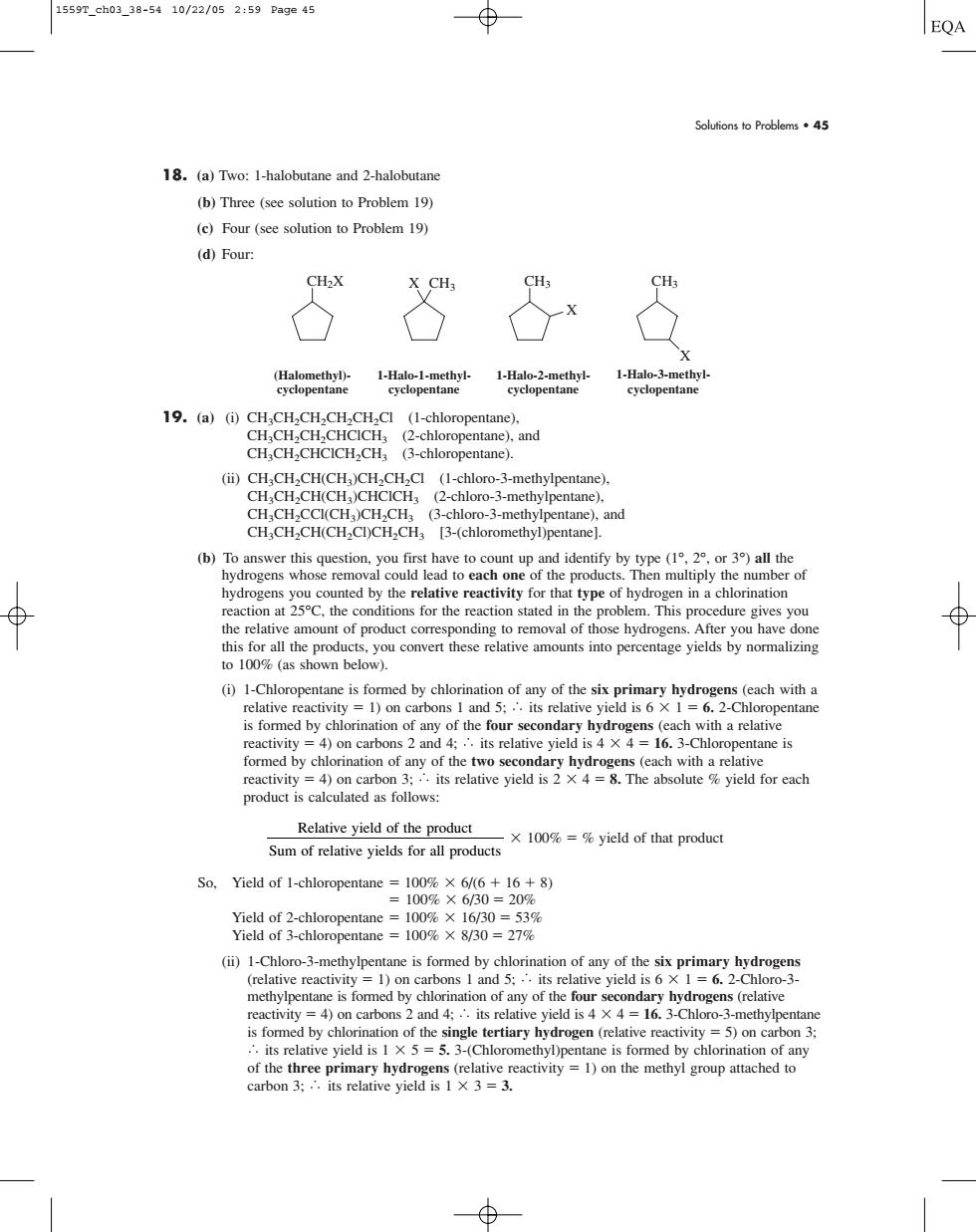正在加载图片...

1559T_ch03_38-5410/22/052:59Page45 ⊕ EQA Solufions to Problems45 18.(a)Two:I-halobutane and 2-halobutane (b)Three (see solution to Problem 19) (e)Four(see solution to Problem 19) (d)Four: CH2X X CHa 19.acH,CH,C用,C() ,and CH CH-CHCICH-CH (3-chloropentane) CH,CH.CCI(CHJ)CH.CH, (3-chloro-3-methylpentane),and CH.CH2CH(CH2Cl)CH2CH3 [3-(chloromethyl)pentane]. (b)To answer this question.you first have to count up and identify by type (1e.2.or 3)all the hydrogens whose remo ould cad to each one of the product Then multiply the numbr of cedure gives the relative amount of product corresponding to removal of those hydrogens.After you have don his Tor all the pro you convert these relative amounts into percentage yields by normalizing is formed by chlorination of any of the four secondary hydro y4)on carbons 2 and 4:its relative yield is43-Chioropentane is formed by c ield for each Relative yield of the product Sm of raiv yicds forlodyeld of tapoduc So.Yicld of 1-chloropentanc 100%x 6/(6+16+8) =100%X6/50=209 Chloro-3-mcthylpentane is fomdieldrimayyr carbons 2 its relativ 16.3Chloro-3-mcthylpentan o-3api3Sn0o四eao of the three primary hyd 1)on theme uced Solutions to Problems • 45 18. (a) Two: 1-halobutane and 2-halobutane (b) Three (see solution to Problem 19) (c) Four (see solution to Problem 19) (d) Four: 19. (a) (i) CH3CH2CH2CH2CH2Cl (1-chloropentane), CH3CH2CH2CHClCH3 (2-chloropentane), and CH3CH2CHClCH2CH3 (3-chloropentane). (ii) CH3CH2CH(CH3)CH2CH2Cl (1-chloro-3-methylpentane), CH3CH2CH(CH3)CHClCH3 (2-chloro-3-methylpentane), CH3CH2CCl(CH3)CH2CH3 (3-chloro-3-methylpentane), and CH3CH2CH(CH2Cl)CH2CH3 [3-(chloromethyl)pentane]. (b) To answer this question, you first have to count up and identify by type (1°, 2°, or 3°) all the hydrogens whose removal could lead to each one of the products. Then multiply the number of hydrogens you counted by the relative reactivity for that type of hydrogen in a chlorination reaction at 25°C, the conditions for the reaction stated in the problem. This procedure gives you the relative amount of product corresponding to removal of those hydrogens. After you have done this for all the products, you convert these relative amounts into percentage yields by normalizing to 100% (as shown below). (i) 1-Chloropentane is formed by chlorination of any of the six primary hydrogens (each with a relative reactivity 1) on carbons 1 and 5; its relative yield is 6 1 6. 2-Chloropentane is formed by chlorination of any of the four secondary hydrogens (each with a relative reactivity 4) on carbons 2 and 4; its relative yield is 4 4 16. 3-Chloropentane is formed by chlorination of any of the two secondary hydrogens (each with a relative reactivity 4) on carbon 3; its relative yield is 2 4 8. The absolute % yield for each product is calculated as follows: 100% % yield of that product So, Yield of 1-chloropentane 100% 6/(6 16 8) 100% 6/30 20% Yield of 2-chloropentane 100% 16/30 53% Yield of 3-chloropentane 100% 8/30 27% (ii) 1-Chloro-3-methylpentane is formed by chlorination of any of the six primary hydrogens (relative reactivity 1) on carbons 1 and 5; its relative yield is 6 1 6. 2-Chloro-3- methylpentane is formed by chlorination of any of the four secondary hydrogens (relative reactivity 4) on carbons 2 and 4; its relative yield is 4 4 16. 3-Chloro-3-methylpentane is formed by chlorination of the single tertiary hydrogen (relative reactivity 5) on carbon 3; its relative yield is 1 5 5. 3-(Chloromethyl)pentane is formed by chlorination of any of the three primary hydrogens (relative reactivity 1) on the methyl group attached to carbon 3; its relative yield is 1 3 3. Relative yield of the product Sum of relative yields for all products (Halomethyl)- cyclopentane CH2X 1-Halo-1-methylcyclopentane X CH3 1-Halo-2-methylcyclopentane CH3 X 1-Halo-3-methylcyclopentane CH3 X 1559T_ch03_38-54 10/22/05 2:59 Page 45����������������������